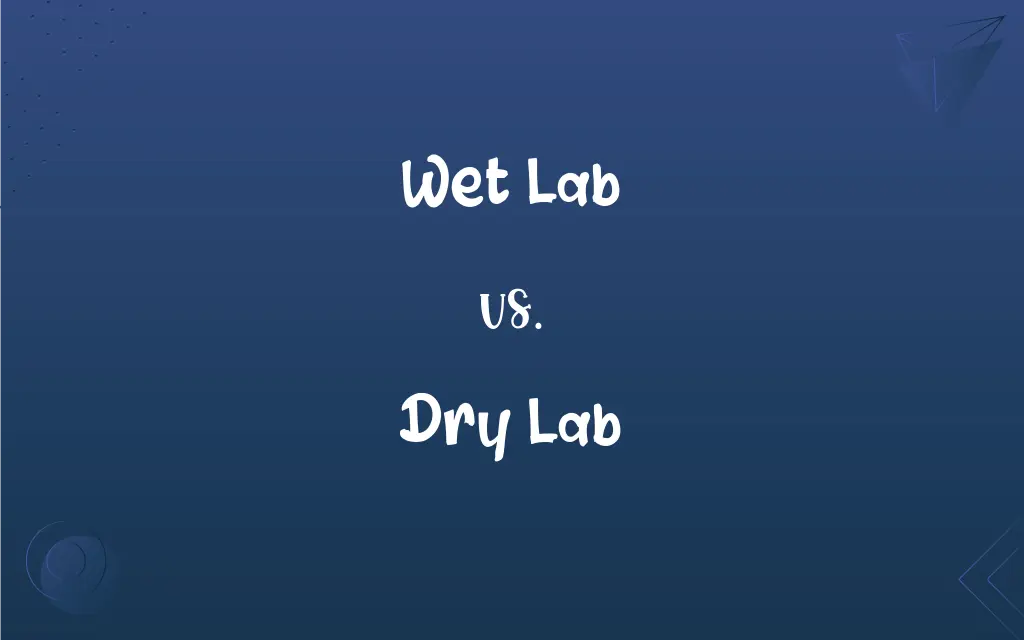Wet Lab vs. Dry Lab: What's the Difference?
Edited by Janet White || By Harlon Moss || Updated on October 11, 2023
Wet labs involve practical experiments with chemicals and biological matter, while dry labs primarily focus on computational or theoretical research without involving wet substances.

Key Differences
Wet labs are distinctive for their usage of chemicals, biological specimens, and various liquids to conduct experiments, embodying a more hands-on, experimental approach to research. Conversely, dry labs utilize computational methods, software, and theoretical models, which distinctly omit the physical and chemical experimental component found in wet labs.
Engaging with materials and data, wet labs often demand specific infrastructure to manage chemical storage, waste, and safety equipment, ensuring secure handling of potentially hazardous substances. In contrast, dry labs, relying on computational and analytical work, necessitate technical infrastructure like servers, workstations, and relevant software, fostering an environment focused on data analysis and modeling.
The scientific investigations occurring in wet labs typically involve direct experimentation, such as chemical reactions, biological testing, and materials science investigations, utilizing tangible samples and materials. In a stark contrast, dry labs often delve into bioinformatics, computational biology, and theoretical studies, working with digital data and computational simulations rather than tangible samples.
With regards to educational and research contexts, wet labs provide an empirical and tactile experience, enhancing understanding through direct interaction with materials and reactions. Meanwhile, dry labs offer an environment where analysis, algorithm development, and simulations prevail, thus, deriving insights primarily from data, computations, and theoretical underpinnings.
The collaborative and interdisciplinary nature of scientific research often necessitates that wet lab and dry lab approaches complement each other, with wet labs generating empirical data and dry labs providing computational analysis and modeling, enriching the comprehensiveness and depth of research outcomes.
ADVERTISEMENT
Comparison Chart
Primary Focus
Physical experiments involving liquids, chemicals, and specimens
Computational and theoretical research
Infrastructure
Equipped for safe handling of chemicals and biological materials
Focused on computational and IT infrastructure
Research Approach
Direct, empirical experimentation
Data analysis, simulations, and modeling
Safety Concerns
Chemical, biological, and physical safety concerns
Primarily data security and management
Data Origin
Generates data through experimental work
Analyzes existing or simulated data
ADVERTISEMENT
Wet Lab and Dry Lab Definitions
Wet Lab
In a wet lab, data is often generated through hands-on experimental processes and observations.
Data collected from the wet lab was crucial in understanding the new biological phenomenon.
Dry Lab
A dry lab emphasizes handling and interpreting digital or previously recorded data rather than conducting physical experiments.
The researchers in the dry lab were analyzing data obtained from various global databases.
Wet Lab
Wet labs are facilities designed to handle chemicals, biological samples, and other fluid materials safely.
The university built a new wet lab to accommodate the increasing number of chemistry students.
Dry Lab
In a dry lab, scientists engage in algorithm development, simulation modeling, and data analysis without physical experimental setups.
Utilizing data from physical experiments, the dry lab was focused on constructing predictive models for reactions.
Wet Lab
A wet lab involves direct, tangible experimentation with physical materials.
The wet lab was bustling with researchers studying the properties of various compounds.
Dry Lab
A dry lab employs computational and theoretical approaches for research without using chemical substances.
The dry lab focused on developing algorithms for analyzing genetic data.
Wet Lab
Wet labs necessitate specific safety and storage protocols for handling potential risks with substances.
All students were trained on safety protocols before starting work in the wet lab.
Dry Lab
Dry labs often involve research areas like bioinformatics, computational biology, and statistical analysis, avoiding tangible sample use.
A groundbreaking bioinformatics tool was developed in the dry lab to decode complex genomic sequences.
Wet Lab
A wet lab is a laboratory where researchers conduct experiments using liquids and other substances.
Scientists in the wet lab carefully mixed chemicals to observe the resulting reaction.
Dry Lab
Dry labs predominantly utilize computer systems, data analysis software, and mathematical models for scientific inquiries.
In the dry lab, scientists were engrossed in simulating protein folding using specialized software.
FAQs
What distinguishes a dry lab from a wet lab in terms of experimental approach?
Dry labs focus on computational and theoretical research, while wet labs engage in hands-on physical experiments.
What kind of infrastructure is predominantly found in a dry lab?
Dry labs primarily contain computers, servers, and data storage systems.
Are wet labs more prone to safety risks compared to dry labs?
Generally, yes, due to the handling of chemicals and biological materials.
Do wet labs and dry labs require different safety certifications?
Yes, due to different materials and data handled, safety and compliance requirements differ.
What is a common workflow involving both wet and dry labs in genomic research?
Wet labs generate genomic data, which dry labs subsequently analyze, model, and interpret.
How do wet labs validate hypotheses derived from dry lab research?
By conducting physical experiments to test predictions and models developed in the dry lab.
Can wet lab and dry lab methodologies be integrated in research?
Yes, often wet lab-generated data is analyzed and modeled in a dry lab.
How crucial are dry labs in the era of data-driven science?
Very crucial, as they facilitate data management, analysis, and derive insights from vast datasets.
How do wet labs contribute to drug development?
Wet labs perform critical experiments, testing, and validation in the drug development process.
What kinds of chemicals are typically used in a wet lab?
Varies widely, from reagents, solvents, acids, to specialized chemicals depending on the research.
What expertise is typically required for dry lab research?
Proficiency in data analysis, computational skills, and knowledge of theoretical models.
Can research be conducted solely in a wet lab without dry lab involvement?
Yes, though incorporating dry lab analytics can often enhance research depth and application.
Can dry labs support epidemiological studies?
Yes, dry labs can model, simulate, and analyze epidemiological data to derive insights.
Do wet labs require more physical space compared to dry labs?
Typically yes, due to the need for storage, safety apparatus, and experimental setups.
What types of specimens are typically found in a wet lab?
Wet labs may contain chemicals, biological organisms, cells, tissues, and various experimental apparatus.
What educational aspects does a wet lab bring to scientific training?
Wet labs offer hands-on experimental skills, practical problem-solving, and empirical methodology training.
Can dry labs engage in collaborative research across the globe?
Yes, dry labs can collaborate globally, sharing and analyzing data without geographical constraints.
What type of research is typically conducted in a wet lab?
Wet labs usually conduct experimental research involving chemicals, biological specimens, and other physical substances.
Is data analysis an exclusive domain of dry labs?
Not exclusive, but dry labs predominantly focus on computational data analysis.
What roles do dry labs play in bioinformatics research?
Dry labs handle data analysis, algorithm development, and computational modeling in bioinformatics.
About Author
Written by
Harlon MossHarlon is a seasoned quality moderator and accomplished content writer for Difference Wiki. An alumnus of the prestigious University of California, he earned his degree in Computer Science. Leveraging his academic background, Harlon brings a meticulous and informed perspective to his work, ensuring content accuracy and excellence.
Edited by
Janet WhiteJanet White has been an esteemed writer and blogger for Difference Wiki. Holding a Master's degree in Science and Medical Journalism from the prestigious Boston University, she has consistently demonstrated her expertise and passion for her field. When she's not immersed in her work, Janet relishes her time exercising, delving into a good book, and cherishing moments with friends and family.
































































